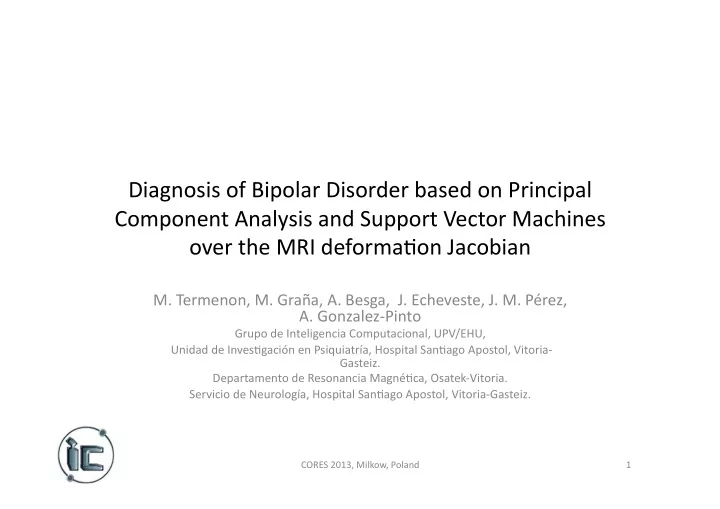

Diagnosis of Bipolar Disorder based on Principal Component Analysis and Support Vector Machines over the MRI deforma@on Jacobian M. Termenon, M. Graña, A. Besga, J. Echeveste, J. M. Pérez, A. Gonzalez‐Pinto Grupo de Inteligencia Computacional, UPV/EHU, Unidad de Inves@gación en Psiquiatría, Hospital San@ago Apostol, Vitoria‐ Gasteiz. Departamento de Resonancia Magné@ca, Osatek‐Vitoria. Servicio de Neurología, Hospital San@ago Apostol, Vitoria‐Gasteiz. CORES 2013, Milkow, Poland 1
Contents • Introduc@on and mo@va@on • Materials • Methods • Results • Conclusions CORES 2013, Milkow, Poland 2
Introduc@on • Bipolar disorder (BD) – psychiatric disorder • at least one episode of mania or hypomania • or a mixed episode <‐> a depressive episode, • changes in mood states and psycho@c symptoms. • It is associated with cogni@ve, affec@ve and func@onal impairment. • A diagnosis BD – symptoms, – course of illness and, – family history, – neuroimaging • iden@fied several regions that are affected by the disease CORES 2013, Milkow, Poland 3
Introduc@on • we compare brain structural MRI of healthy controls with pa@ents with bipolar disorder, – to discriminate between both groups – selec@ng relevant informa@on embedded in the images. • Machine Learning (ML) – of feature vectors extracted from the deforma@on of the structural MRI images – computer aided diagnosis (CAD) tools. • Preprocessing, – registra@on of the volumes, – affine and non‐linear registra@ons to a standard MNI template. • The Jacobian of the deforma@on at each voxel will be used to extract the relevant features CORES 2013, Milkow, Poland 4
Materials • Pa@ents recruited at the psychiatric unit at Alava University Hospital, Vitoria (Spain) • All pa@ents were living independently in the community. – clinical evalua@on, – a cogni@ve and a neuropsychological evalua@on, – and brain imaging (MRI). • Forty men and women elderly subjects were included in the present study. – The healthy control group included 20 subjects without memory complaints • (mean age 74.10 (SD:8.03 years)) – and BD group included 20 subjects fulfilling DSM IV’s criteria • (mean age 70.37 (SD: 9.07 years)). • Subjects with psychiatric disorders (i.e. major depression) or other condi@ons (i.e. brain tumors) were not considered for this study. • Structural MRI 3D data (T1‐weighted). CORES 2013, Milkow, Poland 5
Methods • Image preprocessing – Affine and elas@c registra@on – Tensor deforma@on map – Jacobian at each voxel • Feature selec@on – Voxel sites with dis@nc@ve values of the deforma@on Jacobian – Dimension reduc@on: PCA • Classifica@on: – Linear SVM – Valida@on: Leave One Out CORES 2013, Milkow, Poland 6
Methods CORES 2013, Milkow, Poland 7
Methods • Feature selec@on – Compute voxel‐wise means of each class • healthy controls • BD pa@ents – Compute histogram of class means differences – Select the tail percen@le according to a threshold CORES 2013, Milkow, Poland 8
Methods • Classifica@on performance measures CORES 2013, Milkow, Poland 9
Results Voxel loca@ons for feature selec@on with threshold 0.4 CORES 2013, Milkow, Poland 10
Results 3 first PCA before (lel) and aler (right) feature selec@on CORES 2013, Milkow, Poland 11
Results CORES 2013, Milkow, Poland 12
Results CORES 2013, Milkow, Poland 13
Conclusions • Free of circularity – Feature selec@on is performed in each LOO step – PCA is unsupervised • Selected voxels are located in – thalamus and angular gyrus, • precuneous cortex, precentral and postcentral gyrus, supramarginal gyrus, rightlateral ventricle, superior parietal lobe, inferior temporal gyrus and cerebellum. • Thalamus is one of the most relevant biomarkers in bipolar disorder • Also superior parietal lobe , precuneous cortex, precentral gyrus and Cerebellum. • Valida@on of the approach – with no disease a priori informa@on we find brain discriminant regions consistent with known biomarkers of BD CORES 2013, Milkow, Poland 14
Recommend
More recommend